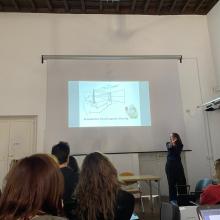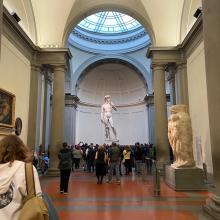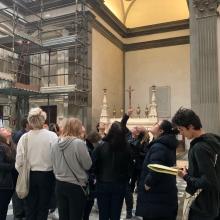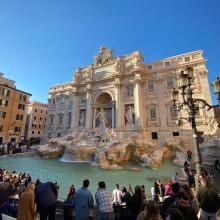The School of Art + Art History + Design has been sending study abroad programs to Italy for many years, but winter quarter 2020 saw something new. This was the first time that one program combined faculty and students from the Divisions of Art and Art History. Twenty-nine students participated in this program themed "Materials, Making, Meaning," which challenged them to think about how artistic decisions have fashioned visual meaning in art from the Renaissance to the present day. The first half of the quarter was led by Photo/Media Professor Ellen Garvens and Art History Professor Estelle Lingo. Interdisciplinary Visual Art Associate Professor Curt Labitzke and Art History Associate Professor Stuart Lingo led the second half of the quarter.
While it was unfortunate that the coronavirus/COVID-19 crisis caused them to depart early from Rome, it was still a very worthwhile experience. This is what six of the students had to say about it:
Marco Ammatelli
Undergraduate, Art
When I reflect on my time in Italy, I realize my most impactful experience was not so much an isolated event but a process. It did not arise, as once expected, from viewing a notable work of art or visiting a notable site — though such revelations certainly did occur. Instead, it arose from something far more simple: the act of taking a walk.
For me, the moment occurred one morning while exploring Parco della Caffarella. Along a narrow section of the Almone River, I stumbled upon a site of entanglement unlike any I have ever witnessed, the accumulation of branches, roots, trash, and debris forming a profane yet strangely sacred clot. From both near and afar, the landscape presented a paradoxical illusion, at once flat yet deep, convoluted yet ordered, polluted yet profoundly beautiful. I visited the site often throughout the quarter, and each time it reframed how I think about not only ecological resilience but also conservation — what is preserved, what is left in ruin, and what is ultimately reclaimed.
In the end, this initial observation made learning and making art in Rome that much more meaningful. Whether admiring faded sinopie, visiting a leading art restoration lab in Florence (truly incredible), or taking yet another walk along the Tiber, I was reminded of the imperative to care for landscapes — cultural, ecological, and otherwise — that make us human.
Above all, I am thankful for the opportunity to wander in a place like Rome, a city known to introduce itself in subtle layers, and I am thankful for the openness living abroad affords. In the future, I hope to maintain this openness, both in studio practice and life, as I continue to explore and contemplate what comes next after graduation.
Sarah Falk
Undergraduate, Art
Walking through the doorway into the Sistine Chapel, I turned and was bombarded by the sight of Michelangelo's Last Judgement. The work, bathed in the light filtering through the windows, made brighter by the overcast sky of that day, stood more vibrant than any picture of it has ever managed to capture. Standing in the center of the room surrounded by strangers with my neck craned back, tears began to slide down my face. The single painting, let alone the entirety of the ceiling, was overwhelming and debilitating to say the least. After recovering, I let my thoughts run rampant rethinking every aspect I've studied about the paintings, the artist, and the place. Eventually, I left in a still-dazed state with a strong feeling of affirmation for the life I've made for myself in the arts and an excitement for the future.
Ashley Grammer
Undergraduate, Art
Studying abroad at 32 years old was not something I ever thought I would be able to do. I had already built a life with a partner, had a job, bills to pay, etc. Leaving for 3 months did not seem feasible. However, when the opportunity presented itself, I felt compelled to make some sacrifices and just go for it. So, off to Italy I went. At first, being roomed with 6 other people was quite the adjustment. I have been way past the roommate stage of my life for years! Not to mention, being surrounded by people who do not speak my native language, living in a more conservative culture, and a slightly less progressive way of living was also quite uncomfortable. Although uncomfortable, these are all seemingly small things that left an astronomical impact on my life’s perspective. I discovered what I do and don’t actually need in my life. I learned that saying literally everything on my mind to anyone with ears that can hear me isn’t necessarily a good thing and taking a step back to listen and observe my surroundings is just as, if not more, valuable. I discovered that feeling slightly uncomfortable on a regular basis made me more level headed, less bothered by small things, more observant, and more appreciative of what I have. I can legitimately say I came back home a better, more mature person.
Caroline Harvey
MA student, Art History
Studying art in Rome is so conducive to creation, whether it be research-based or artistic, and the incredible work done by the Art and Art History faculty to really integrate an historical context within a creative process made for a unique opportunity. The collaboration of Art and Art History for the "Materials, Making, Meaning" study abroad program in Rome encouraged very fruitful cross-disciplinary collaborations. As a graduate student in Art History, I rarely interact with the faculty outside of my division. Getting to know Ellen Garvens and Curt Labtizke was such a treat and, had I not participated in the program, I likely would have graduated without having ever met them. I believe this must have had a similar effect for the undergraduate students. Even though we are all in the same building, the administrative divisions within the School of Art + Art History + Design can often experience a silo effect. I hope this program is held again in the future and that our three divisions find more ways to collaborate.
Samantha Seaver
Undergraduate, Art History
A monumental perk of going on a faculty-led study abroad is the faculty’s connections. The Professors Lingo from Art History were able to secure us an insider-tour of the Opificio delle Pietre Dure in Florence — one of the most renowned art restoration and conservation institutes on the planet. Our group was led by an employee who casually mentioned that he had restored a Donatello statue, and he walked us through the whole institute. Around every corner, the world’s top conservators were mixing chemicals and plugging in x-ray machines to restore artworks we had studied for years. Not to boast, but my nose was inches away from a Raphael at one point. Ellen Garvens, a Photo/Media professor, turned her head and was face-to-face with Domenico Veneziano’s Santa Lucia altarpiece — her favorite painting from her undergrad years. She had tried to find it in every museum we went to in Florence and then there it was, so close she could reach out and touch it. After two months of attending museum after museum, the fragile rawness of the institute was at first mildly unsettling and then so meaningful that there were tears shed (not just mine, I swear.) Since this experience, I stood two feet closer to the paintings in every Italian museum I went to, searching for the signs of restoration, the remarkably human touches, that we were taught to look for.
Jake Waits
Undergraduate, Art History
Rome is a city that seems almost incapable of containing itself. From the streets brimming with artistic artifacts and monuments of histories past to the extravagantly ornamented Baroque basilicas, Rome left me without a single moment of banality. This conflation of visual histories layers the city into an amalgam of architecture extending from the Roman Empire to the 21st century that seems to extend to the very intricate detail of each individual space. It is this radiation of detail, from the very meticulously placed baroque coffer to a church occupying the small space that remains within a street corner already engulfed in Roman ruins, that made the experience of studying in Rome so impactful. It is a city that appears overwhelmed in its saturation of historical monuments, yet it, at the same moment, continues growing through a new history, through the people who move through the city almost unaware of what surrounds them. It is an environment so inundated with art that art itself nearly becomes common, disappearing into the fabric of the very city it constructs. Living and studying in a city where art and everyday life are inextricably, physically linked had an effect on me far greater than any singular work or site. While seeing these more isolated works (a Raphael, Michelangelo, Bernini, or Caravaggio, etc.) were, of course, magnificent, the opportunity to become — for a few months — a part of the 'living museum' that is Rome is an experience I will forever appreciate.





